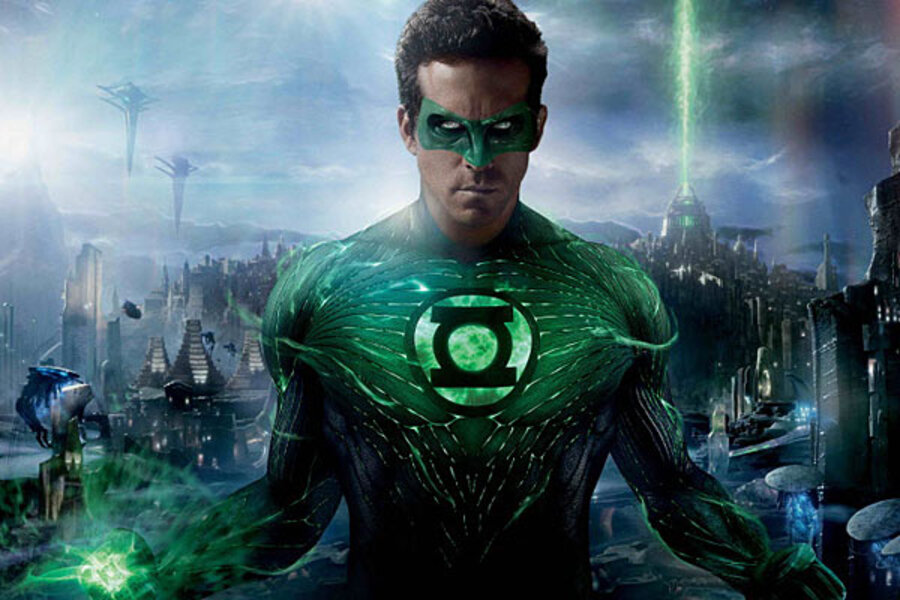Superhero summer: Behind 'Green Lantern' and the rest, an American story
Loading...
| Los Angeles
It’s a super-sized summer slate of comic book heroes, as movie studios scramble to launch the next, long-running franchise by exploring lesser-known names from the classic American storytelling genre. Green Lantern is just the latest to make the leap to the big screen.
It’s also a record season of movies packed with “origin stories.” These tales fill in the hero’s background. After all, people may pay to see the latest Batman or Superman adventure, but most will need an introduction to the wider canon of Green Lantern, Captain America, or even Thor.
But while the bigger-than-life do-gooders are universal, the stories behind their creation are uniquely American.
They have evolved as the country has tackled waves of immigration, foreign wars, the threat of nuclear annihilation, civil rights, and the challenges of cultural diversity over the past 70 years.
Along with the popcorn and candy, audiences are consuming a deeply American art form. Like jazz and the Broadway musical, comic books were created by artists whose own origins mirror the national narrative of a country forged from the heartbreak and hard work of generations of immigrants and outsiders.
“Virtually all the artists who really created comic books in the ‘30s and ‘40s were Jewish and children of parents who came from places like Poland, Lithuania, and Russia,” says Stephen Fishler, comic book expert at the Manhattan auction house, Metropolis Collectibles.
“Superman co-creator Jerry Siegel’s parents were Lithuanian Jews, “Batman” creator Bob Kane was born Robert Kahn, and Stan Lee’s real name is Stanley Martin Lieber.
“There is a certain powerlessness associated with being Jewish in America, particularly in those days,” he says. Mr. Siegel’s father was killed during a nighttime robbery in his secondhand clothing store in Cleveland when Mr. Siegel was 18, he notes.
“It’s not hard to see that creating a character who falls from an alien planet and develops the power to make bullets bounce off his chest might be an artist’s way of fighting back against the chaos and anti-Semitism of that time,” he says.
While Green Lantern creator Martin Nodell was born in Philadelphia of Jewish parents, his mother emigrated from the Ukraine.
“She came through Ellis Island,” says granddaughter and comic book scholar Jacque Nodell, adding, “my grandfather was very aware that putting ‘Jewish’ on a job application would keep him from getting work.”
She says he got the idea for Green Lantern while waiting for a subway train in Brooklyn. In those days, conductors signaled stop and go with actual lanterns, operated manually. “When my grandfather saw the green lantern flash on it just seemed to represent the spirit of possibility, of moving forward,” she says, the essence of the American promise.
When the X-Men characters were created at the dawn of the civil rights decade in 1962, creator Stan Lee was consciously making an allegory for “otherness,” says Brad Ricca, author of the upcoming, “Super Boys.”
“You did not want to weigh down a comic book with the pondersome issues of the day, but you could create characters who are born different and suffer for those differences,” says Mr. Ricca.
The American story has evolved through the comic book world.
“Fifty years ago we saw man versus science with the shadow of the atomic age hanging over stories such as the Hulk and Spiderman, both of whom are accidents of the nuclear age,” says Gotham Chopra, co-author of “The Seven Spiritual Laws of Superheroes,” but today the story has gotten much bigger.
“Now we are in an age of man versus spirit,” he says. “People are trying to make sense of what can seem like desperate, very big times.”
Comic book artists consciously tapped into myths and powers from all over the world, again echoing a deeply American ability to meld many cultures into a single nation.
This ability to draw from powers and traditions not only from all over the globe, but of course, in many cases such as the Green Lantern, from all over the cosmos, is a very American story, adds Chopra.
Audiences may not think about such things in the cool darkness of a movie theater, “but these stories appeal to timeless desires to find our place in a large and confusing world.”





